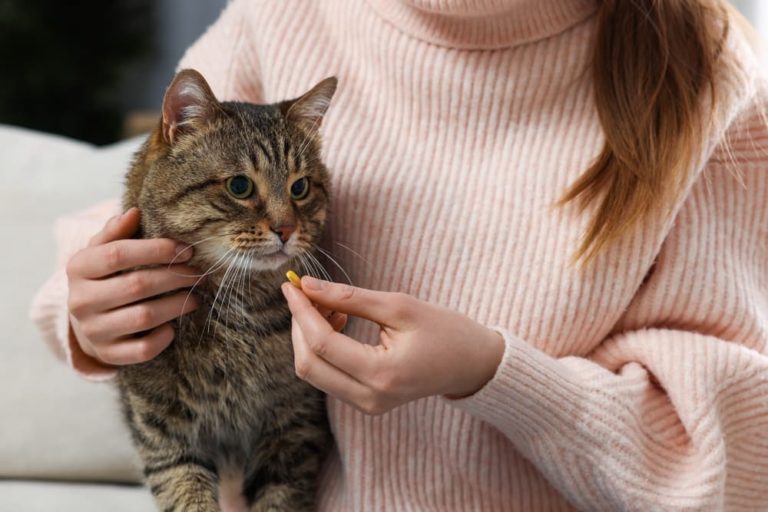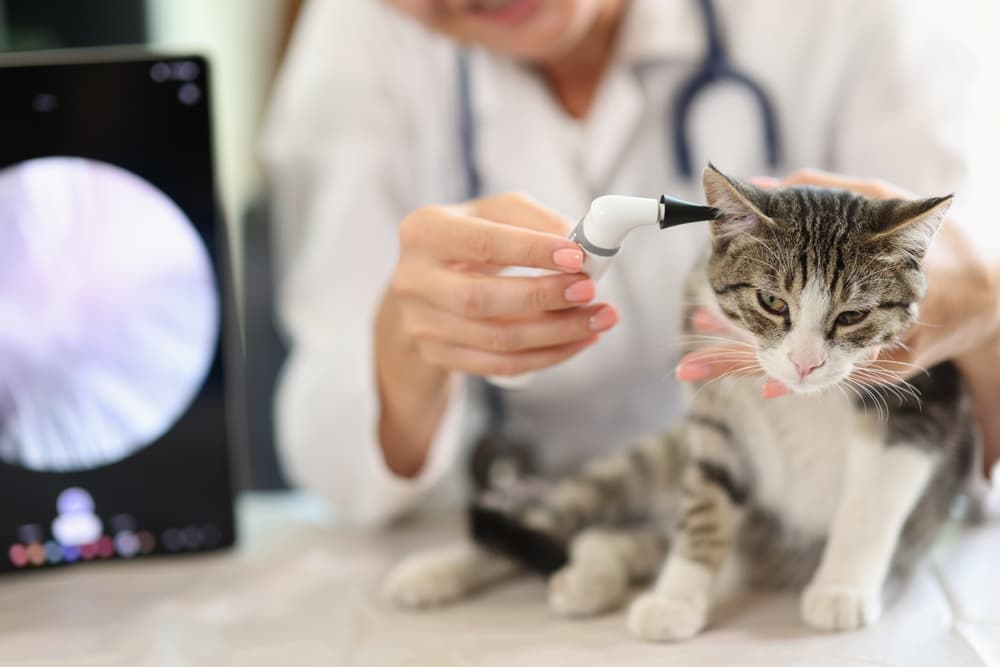Baytril (Enrofloxacin) for Cats

Medication details
- Medication type: Antibiotic
- Form: Pill, Tablet, Topical, Injection
- Prescription required? Yes
- FDA approved? Yes
- Brand names: Baytril, Baytril otic
- Common names: Enrofloxacin
- Available dosages: 22.7 mg, 68 mg, 136 mg, 22.7 mg/mL
Antibiotics for cats fall into a number of different categories. We have come a long way since the initial discovery of penicillin!
As bacteria evolve new ways to evade our antibiotics, we must constantly develop new antibiotics that can give us the upper hand against infections. Baytril, or enrofloxacin, is one such antibiotic. It was developed to treat challenging bacterial infections and is now used to treat a variety of infections in cats, dogs, and other animal species.
What is Baytril?
Baytril is a broad-spectrum antibiotic, known by the generic name of enrofloxacin. It belongs to a class of antibiotics known as fluoroquinolones.
Baytril was developed in 1983. It became commercially available in 1988. Since then, it has been widely utilized to treat a variety of infections in cats. It is also used in dogs and other species, including cattle, rabbits, hamsters, birds, and reptiles.
Baytril is most commonly prescribed as an oral tablet. In the case of an external ear infection, however, your veterinarian may instead prescribe Baytril otic drops, which are designed to be instilled into the ear canal. Hospitalized cats may receive injectable Baytril, especially if they are not eating or drinking.
Is Enrofloxacin Safe for Cats?
Enrofloxacin is widely used in cats, with most cats experiencing few (if any) side effects. When side effects do occur, they are typically mild.
Most veterinary practices stock Baytril, so you can often obtain this medication from your regular veterinarian. A visit to a specialist is not needed for treatment with Baytril.
What Does It Look Like?
Baytril’s appearance may vary, depending on the formulation that is prescribed by your veterinarian.
In most cases, veterinarians prescribe oral Baytril pills for cats. These pills may be a tan/brown chewable tablet or a purple coated tablet.
In the case of a cat ear infection, your veterinarian may prescribe Baytril otic drops. These ear drops come in a white bottle with a purple label.
How Does Baytril Work?
Baytril kills sensitive bacteria by preventing the replication of bacterial DNA (genetic material).
Unlike some other cat antibiotics, Baytril reaches a wide variety of tissues within the body. This includes areas that may have poor circulation, such as abscesses. This characteristic makes Baytril a commonly-used antibiotic for certain types of infections.
What Is Baytril Used For in Cats?

Baytril is effective against a broad range of bacteria, and it can penetrate a wide variety of bodily tissues. While it may be a veterinarian’s first choice of antibiotics for a particular infection, it can also be used to treat infections where other antibiotics have proven ineffective.
Infections for which your veterinarian may prescribe Baytril include:
- Cat bite abscess
- Skin infection
- Ear infection
- Anal sac infection
- Pneumonia
- Osteomyelitis (bone infection)
- Urinary tract infection
How to Give Baytril to Cats
Baytril tablets are best given on an empty stomach. This increases the drug concentration in your cat’s body, maximizing its antibiotic effect. However, if your cat experiences vomiting, diarrhea, or other gastrointestinal effects, you may choose to give Baytril with food. Giving Baytril with food can reduce the risk of an upset stomach.
Baytril tablets come in two forms: chewable or enteric coated tablets. The chewable tablets can be crushed and mixed with a small amount of canned food or soft treats. The enteric-coated tablets, however, should not be crushed. Enteric coated tablets have a bitter taste once the coating has been removed. If your veterinarian prescribes enteric coated tablets, you will need to learn how to pill your cat.
Baytril otic drops are administered directly into your cat’s ear(s).
Enrofloxacin for Cats Side Effects
Baytril is typically well-tolerated by cats. However, like any other antibiotic for cats, Baytril can have side effects.
The most common side effects in cats include vomiting, diarrhea, decreased appetite, and lethargy. These effects are more common if Baytril is given on an empty stomach. Giving your cat Baytril with food may reduce the risk of these side effects.
Rarely, cats experience seizures or retinal degeneration (blindness) when treated with high doses of Baytril. These effects are rare in healthy cats. If your cat falls into a group that places them at higher risk of severe side effects, your veterinarian will carefully balance the risks and benefits of Baytril.
Potential Baytril side effects in cats:
- Vomiting
- Diarrhea
- Decreased appetite
- Lethargy
- Seizures
- Retinal degeneration
- Blindness
Reactions With Other Drugs and Medications
Baytril can interact with other medications. Be sure your veterinarian is aware of any prescription or over-the-counter medications you are giving your cat.
Sulcralfate (a medication used to treat stomach ulcers) and antacids can bind to Baytril in your cat’s stomach, preventing its absorption. If your cat takes antacids or sucralfate, separate these medications from Baytril by at least two hours.
Cats that are taking both theophylline (a cough medication) and Baytril may have higher-than-expected blood levels of theophylline, increasing the risk of side effects.
Baytril can also interact with other antibiotics, enhancing or inhibiting their effects.
Baytril Dosage for Cats

Your cat’s Baytril dose depends on a number of factors, including the infection requiring treatment and your cat’s size. Some infections respond to a relatively low dose of Baytril, while others require higher doses.
Baytril is typically administered once daily. In some cases, your veterinarian may divide your cat’s daily Baytril dose into two smaller doses.
What if My Cat Misses a Dose of Baytril?
If your cat misses a dose of Baytril, give the missed dose as soon as possible. Then, continue giving Baytril every 24 hours (or as directed by your veterinarian) until you finish giving the entire course of antibiotics. It’s important to wait the full prescribed time between doses, in order to minimize the risk of side effects.
Cost of Baytril for Cats
The cost of enrofloxacin for cats can vary significantly, depending on your cat’s dose and your location.
In general, a one-week course of Baytril tablets should cost approximately $30 (or less). You may be able to obtain a generic medication at a lower cost.
Enrofloxacin Storage Instructions
Baytril tablets can be stored at room temperature, out of direct sunlight.
Keep Baytril (especially chewable tablets) out of reach of children and pets, to prevent a potential overdosage.









